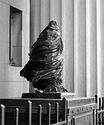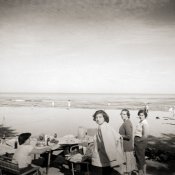I don't share the belief that a photograph will last 500 years. Maybe in about 400 years from now i will let myself be convinced that they can, but now, i doubt it.

Yes, a photograph is an encoded representation of something else. The question thus is what the thing is that the museum wants preserved.
If the photograph itself, anything that adds its own peculiarities, like photogravures do, would be moving away from, instead of preserving, the original.
And it can be argued that a written out scan does that too. You quite simply can't preserve an original other than by preserving the original itself. So good point.
I wouldn't expect that the museum would think that once the written out scan is available, preserving the original is no longer important. On the contrary: to attempt to preserve it through such means is to show how important they think it is to preserve the original.
It also shows that there is little confidence that the original will keep as long as desired. And that's fair, considering that an original can get stolen, destroyed in a calamity of some sort, or get lost (forever) in a number of other ways besides not ageing very well.
The written out scan can be copied as often and as many times as you like without any loss in information, so it would be much safer.
And if (!) the original wouldn't age well, there will be a point in time sooner or later in which whatever you can reproduce using the coded copies will be better than the original in the state it is in then.
So if (again) the original would get worse with age, the fact that what you can reproduce using the copy isn't as good as the original the day it was copied would no longer be that much of a point.
But still: doing the utmost to keep the original in the state it is in now would be the best thing to do by far.






 They know... everybody knows what the digital information is up against, in terms of long term keep. And now there is a big push in the US to digitize medical records- a good idea actually, from the standpoint of information access for clinicians, but what happens when records that somebody really needs simply vanish from the earth?
They know... everybody knows what the digital information is up against, in terms of long term keep. And now there is a big push in the US to digitize medical records- a good idea actually, from the standpoint of information access for clinicians, but what happens when records that somebody really needs simply vanish from the earth?
